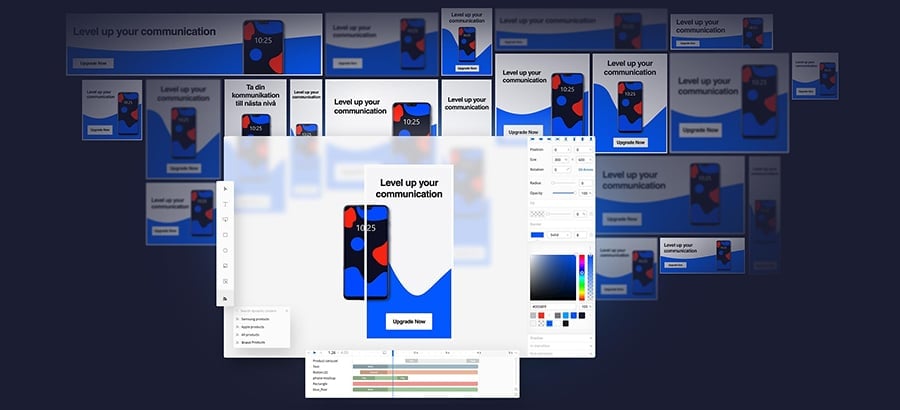
Contextual Targeting in Advertising: The Next Big Trend Revisited
Contextual targeting is back on the agenda of brands and digital advertisers. Previously, overlooked in favour of more privacy-invasive alternatives – post-GDPR the contextual comeback is on.
Interestingly, nearly half of marketers in the US and one third in the UK already describe it as their favourite targeting format. And the truth is: contextual advertising never went away. In fact, its resurgence has the potential to reward display advertisers.
In this article we will answer the following questions about this privacy “friendly” form of targeting:
- What is contextual targeting?
- What are the benefits of contextual targeting?
- Why did contextual targeting “go away”? (It didn’t)
- Why is contextual targeting now making a come back?
- How does contextual targeting in display advertising work?
- What is the future of contextual targeting?
Firstly, what is about contextual targeting that makes it so popular?
1. What is contextual targeting?
Contextual targeting is actually a very old and simple strategy. It is essentially placing the most appropriate ads within the right context. It’s ads placed in the most appropriate place to be read, heard, or watched – and this isn’t (and has never been) exclusive to digital.
For example, brands still buy TV ad spots during programmes that are most relevant to their products. Think betting companies and sports matches; supermarkets during cookery shows; and hair products in women’s magazines. The idea is that the right customer sees the most relevant message.
Contextual targeting definition:
Within digital and display advertising there are two very popular ways to target contextually.
- Directly selecting what creative your ads appear next to, or changing the content of ad creative, based on the content and keywords on a website.
- Targeting (with your Demand Side Platform, DSP, programmatically) and buying ad inventory that matches key words and sentences.
2. What are the benefits of contextual targeting?
The value of using contextual targeting within digital advertising (and particularly display advertising) is strong:
Relevancy
For a start, you can assume whoever views your ads will be more interested in them simply based on the context of the webpage they are visiting.
However, it’s not just that. Today users are tired of non-relevant ad creatives (in the wrong place) that are not relevant to them. Advertisers have to enhance the ad experience with more personalised and relevant ad creatives.
Anti ad fatigue
Interestingly, if you have a good way to detect a very relevant environment, an ad placed next to the right content lifts its value.
This has a positive effect on ad fatigue as a viewer sees ads not just in the right place but the best place for them. And the bonus? The ads and content lift each other too
Privacy friendly
Contextual targeting doesn’t interfere with the user viewing a banner either – it’s 100% about the environment of the page in which an ad is placed. The viewer is essentially anonymous.
The only information the ad tech performing contextual targeting uses is the content of the webpage. And this is to find the most appropriate banner ad for the page.
3. Why did contextual targeting “go away”? (It didn’t)
It didn’t. Indeed, contextual advertising was, for a while, among the dominant forms of online advertising. It just wasn’t super popular because it’s performance was lower than targeting using cookies.
It was easier for some brands to do compared to others
Indeed, for some advertisers contextual usage is natural, as you have good reach. For example, a sports betting company on a sports website for sports. There’s a lot of content or context to base targeting information on.
While, for others, sometimes you may have a niche product to advertise. And this product may have a very niche context and therefore less reach. For example, ice hockey clothing in the UK.
Plus, bigger languages, such as English, were better served by contextual targeting. Unfortunately, when it came to smaller languages, there was a smaller data set for the contextual targeting to use. Plus, less effort from tech companies to rectify this situation.
Behavioural targeting (and cookies) were in demand
However, the biggest impact came from behavioural targeting. As more data about individuals was gathered by a few massive social media platforms, behavioural targeting became popular. And a vast range of programmatic ad tech tools and platforms were adopted to target and retarget users with ads. And thus contextual targeting fell away in usage.
Behavioural targeting, ignores contextual information, such as keywords on a website, and instead determines ad placement using cookies that are already tracking a user. This provides advertisers with far more personalised information on a viewer and can be used to create a digital profile – often created without the user’s knowledge.
And up and till 25th May 2018 this was the way the vast majority of brands performed targeting. However, because of legislation such as the General Data Protection Regulation (GDPR) in Europe, and the California Consumer Privacy Act (CCPA) and restrictions on cookie usage in browsers (e.g. ITP) the era of easy behavioural tracking ceased.
Meaning contextual targeting (and its lack of direct privacy invasion!) is now back in vogue.
4. Why is contextual targeting now making a come back?
The impact of GDPR and the ongoing browser wars are most definitely the biggest drivers in the resurgence of contextual targeting. However, like a great many things in life, it’s not quite as simple as that.
The hunt for the third party cookie replacement
As previously mentioned, contextual targeting does not require third party cookies as it does not target the user directly in any way. However, there is an additional reason for the rise of contextual targeting, and that is the browser war.
Apple’s Safari and Mozilla’s Firefox are now restricting the use of third party cookies and it is likely Google will follow too (in some form). This is set to utterly change the way brands target and retarget in display advertising. Along with European ePrivacy legislation (which will come into force at some point in the near future!).
So what are advertisers doing to target audiences? According to eMarketer research contextual targeting is on the rise, thanks to its greater assurance and security that targeting consumers by content is a more privacy-friendly practice. It is a safe bet.
Better understanding of how to stay brand safe
Brand safety can be an issue with contextual targeting. Indeed, in the past there have been many both funny and awful misalignments. For example, there may be a news article on Nice, a city in France. Yet, being able to tell if the article is a piece about a murder, or the beautiful weather makes a big difference if you are an airline looking to place ads.
Today, the use of machine learning and artificial intelligence(AI) powered technologies provides a more accurate understanding of content. This means brands can now target their audience in a brand-safe way, which includes sentiment analysis. Thus avoiding sensitive content that has the potential to embarass. Hence another reason for the growth in contextual targeting for display advertising.
More advanced AI for content analysis
Indeed, another strong reason for contextual targeting making a comeback is advances in content analysis. The algorithms and AI that analyse the context of web pages is now much better. Not just for finding new placements but really understanding the meaning of the content and pages for the ad placement.
This goes beyond just keywords (as mentioned) but being able to read sentiment and analyse associated imagery. This also includes the use of sophisticated systems that use language-independent proximity pattern matching algorithms to increase matching accuracy. Additionally, publishers have become a lot better at taxonomizing their content.
5. How does contextual targeting in display advertising work?
Contextual targeting in display advertising is simple.
A contextual advertising system scans the text of a website for keywords and returns display ads to a webpage based on the found keywords (or phrases). More advanced contextual targeting systems will scan for additional contextual information (such as alt text) and be able to read the sentiment of the page too – improving relevancy and avoiding issues of brand safety.
However, the way some publisher help advertisers perform contextual targeting with ad inventory can also vary. Contextual targeting can be based on a specific site, channel, page type, keywords, and a taxonomy provided by the site owner. The deeper the taxonomy, the richer the contextual targeting – and the higher the cost.
One key ingredient remains the same, as in all display advertising – the more impactful and engaging the ad creative, the more likely it will drive engagement! In fact having the best creative, in front of the most relevant audience is always a winner.
6. What is the future of contextual targeting?
Future developments in contextual targeting have the potential to take this form of targeting to the next level. But first, there is some trouble on the immediate horizon…
Google will restrict the use of keyword targeting
Programmatically, Google will no longer inform advertisers about the type of content where their ad could appear. Beginning in February 2020, Google is set to no longer include contextual content categories – content identifiers such as “sports,” “news”, or “weather” – in bid requests to ad buyers.
However, these broad category terms, aren’t particularly useful for contextual targeting anyway. Signifiers like “sports” or “weather” are too vague to be worthwhile for companies trying to drill down into contextual data taxonomies.
Additionally, before brands worry – Google is no longer the biggest player in contextual targeting. Currently, many media buyers and DSPs do not rely on Google’s contextual category information and instead use the services of contextual targeting providers such, Oracle owned Grapeshot, Comscore, and Peer39.
Leveraging audience data and context to find customers
Rather than making assumptions on their customers’ content interests, some marketers are connecting first and third party data with actionable intelligence to refine contextual targeting.
They are doing this by identifying effective contextual terms and segments based on existing datasets. As reported, in the drum, these marketers believe that they can address compliance needs without sacrificing advertising performance.
While, in an interview with eMarketer, Philip Smolin, chief strategy officer at marketing technology firm Amobee sees investing in hybrid identity strategies as extremely useful in the future. “The use of first-party combined with panel data, and use of contextual strategies, [means] we continue to perform media buying and optimisation on behalf of a brand in a compliant way.”
Contextual targeting is moving beyond just text
Contextual targeting is set to get an upgrade too. According to GumGum CTO, Ken Weiner, contextual “isn’t just about looking for simple keywords on a page anymore – there’s a lot more on offer today, and it’s getting more and more sophisticated.”
Perhaps the most exciting advance in contextual advertising is the expansion of the capabilities of the format to move beyond just keywords on a page, to analyse additional contextual content such as audio, video, and imagery. And even geo-based info with digital out-of-home (DOOH) placements!
Combined with AI increasing in sophistication, this means marketers are set to achieve a true page-level understanding of contextual content. Meaning a deeper understanding of where to serve ads, which are even more impactful and relevant to consumers.
Future inclusion in creative management platforms
Another bonus with contextual targeting is that very soon it will be a feature in the most advanced creative management platforms (CMPs).
This means, when using a CMP, a marketing team will be able to set up rules that allow them to create a display campaign based on context. Then using the CMP, assign different creatives and different versions to those different contexts.
And of course, being a CMP a brand can scale all the different creative versions required for truly great contextual targeting.
Next steps
In conclusion, it’s clear that contextual targeting in a post-GDPR world is a format of targeting very much on the rise. And for that matter, a format that has the potential to get better and better.
And finally, doing contextual targeting requires digital ads that are both creative and relevant. Therefore, having the best ad tech is essential! If you would like to learn how the Bannerflow creative management platform (CMP) can benefit your next contextual campaign, then get in touch.
Share this article





